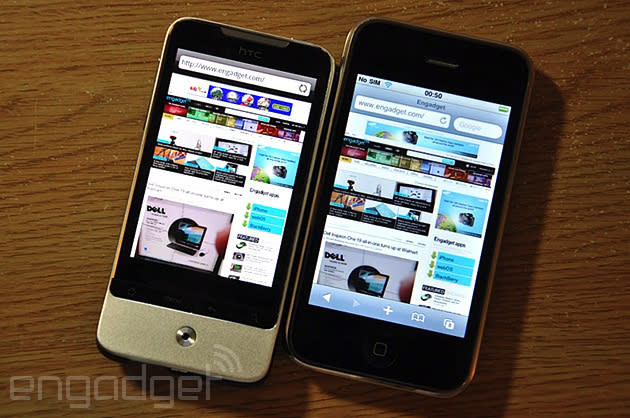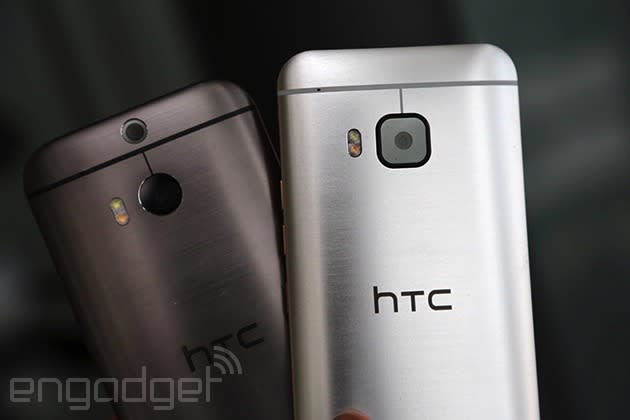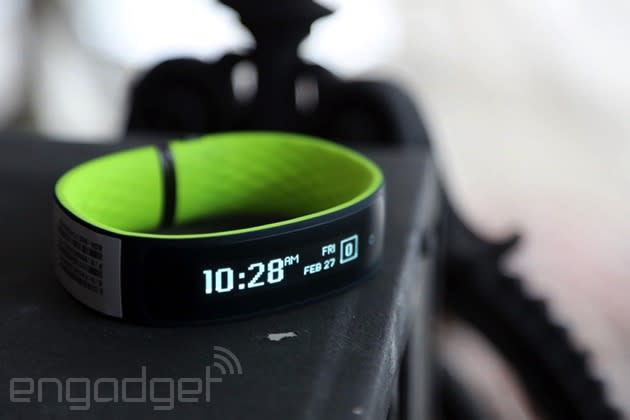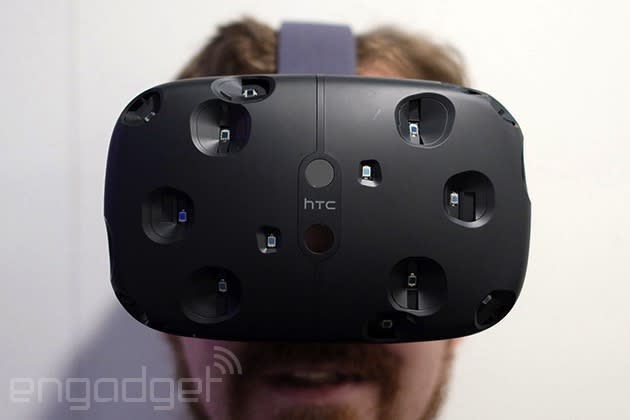HTC's design lead on the One M9, criticism and the promise of VR

The story of HTC's recent fortunes is one of the more bizarre tales in modern technology. What other company releases award-winning flagship after award-winning flagship, only to see revenues and market share drop? For a while, HTC's phones truly stood out in terms of design and build quality (since 2012 there's been the One X, the One M7 and the One M8). The One M9 represents another iterative step forward for HTC, in a product cycle that has (debatably) seen rivals Apple and Samsung make huge leaps forward. But it's not all doom and gloom. Even if the M9 is being mooted as a potential miss, the Vive, its new virtual reality headset, is perhaps the biggest hit of the show. I sat down with the man at the heart of everything HTC does, chief designer Claude Zellweger, to discuss the company's direction, the M9 and its entry into VR.
Design is extremely important to HTC. The company bought One & Co (the consultancy where Zellweger was a principal designer) in 2008, and by 2010, HTC was releasing devices like the Hero, the Nexus One and the aluminum-and-glass Legend. In the age of the Galaxy S and the iPhone 3GS, the Zellweger-designed Legend was really a cut above the rest in terms of materials, design and finish. The iPhone 4 would come a few months later and leapfrog the Legend in precision engineering and -- antennas aside -- quality, but it's the perfect example of how long HTC has been competing at the highest levels of design. Yet Zellweger remains an unassuming, unpretentious and very accessible designer, one who's happy to debate and discuss his craft openly, rather than hiding behind prepared statements.

The HTC Legend and iPhone 3GS, circa 2010.
We begin by discussing the structure at HTC. "We're a design-driven company," he declares, "I report to the CEO; I'm not under engineering or marketing, so our intention can be driven through the company." Indeed, Zellweger's position within HTC is very similar to Jony Ive's in Apple. One & Co remains a fairly distinct entity within HTC -- Zellweger describes the San Francisco studio as "inside [the company], but also outside." Although it's fully owned by (and working exclusively with) HTC, he believes One & Co has retained "the spirit of the team, this open-minded, Silicon Valley-infused group of talented designers."
Looking at the evolution of the One series, it's obvious that Zellweger has a very clear ideal for HTC's flagship. He proudly calls the One "an icon," and it's basically his job to constantly strive to perfect that icon. But although his studio works with a degree of autonomy, there are certain decisions that are dictated. HTC has to update its spec sheet each year to keep up with its competitors, and that brings challenges. While other design teams may be handed components and told to make them work, at HTC, no decision is made alone. "It's a little bit of give-and-take," he explains. "Of course there are some limitations for what we can do, but we definitely have a choice of components. It's important that we understand the benefits to the end user."
This balancing act, of weighing technological advances against utility and beauty, is clearly illustrated by one of the larger differences between the M8 and M9: its camera. Gone is the M8's understated, inset circular camera, replaced with a large, square unit that protrudes slightly from the rest of the phone. Zellweger claims the benefits of the larger, 20-megapixel sensor outweigh the minimal annoyance of a camera bump. He also defends and explains the decision to switch to a square enclosure. "In photography, the photographic icon is round, always, whereas in digital photography, especially in this miniaturized scale, it's a square component. So actually, a square setting is more true, more honest to the component inside."

On the left, the HTC One M8; on the right, the One M9.
In the search for perfection, mistakes are made. Last year's M8 drew criticism for its ergonomics. Although it was more comfortable to hold, it was almost too smooth, too sculpted, and this led to it being slippery. Zellweger pulls out his lightly scuffed personal M8 and admits to it being dropped "a few times" over the past year. To Zellweger, that's obviously unacceptable, and so the compromise of the M9 was born. Look at its sides, and you'll see elements of both the M7's sharp, angular edges, and the M8's soft, sculpted curves.
Design is all about minutiae, and an unbelievable amount of effort goes into creating this combination. Zellweger boasts that each M9 takes five hours to machine -- double the time of the original M7 -- thanks to a convoluted process that basically involves doubling up on everything in order to create the harsh edge and the new two-tone, less slippery finish.
This is what Zellweger calls "meaningful progress and meaningful change," which is the best explanation for why the One hasn't actually changed all that much this time around. Most of the flashy technological advances we've seen -- curved displays, folded displays and their ilk -- don't represent anything meaningful. "[A curved display] is a novelty, right?" he asks, and I nod in agreement. "It definitely draws attention, but it has a massive disadvantage, which is reflections. ... Curved phones give you complex reflections that are distracting. ... Flexible displays have the same problem; there are a lot of reflections and inconsistencies in the image quality."
"We're not going to create a new icon just because marketing tells us that we need something different on the shelves."
When I ask how long HTC will carry on pursuing this iterative direction until it moves onto a new design, it elicits an almost inaudible sigh. Our talk is just one in a long line of interviews and engagements for Zellweger -- MWC is perhaps the biggest week of the year for the company -- and from the tired look in his eyes, it's clear he's been asked this question several times. "We're not going to create a new icon just because marketing tells us that we need something different on the shelves," he retorts. "We definitely believe in just giving users the right things, and we feel like this is an icon that has matured. ... Even if the technology is there, we will wait until there's a real application for it."
Having a single, visible and very accessible design chief is unusual in the tech world. Zellweger's counterparts at Samsung and Apple might be aware of those critiquing their products, but they don't really have to address that criticism publicly. Over the years, I've written some pretty horrible things about the design of products, yet I have only a modicum of formal training in the field. Do I, does anyone have the right to critique the work of a trained designer? Apparently so. "The last thing I'd claim is that design is something exclusive, or that you have to be trained to judge. ... Everybody is a judge of design," he says. "Of course, you can argue that a person had less exposure to culture and so on, but tastes change, and that to me shows that even for those that are design-trained, taste isn't a fixed thing."
Tastes do change. Designers have to move with the times, and Zellweger has both been inspired and inspired others during his time at HTC. In a 2010 interview regarding the launch of the Legend, he noted that "all designers are influenced by Apple," to the extent that the company had "set the standard" in industrial design for phones. Jump forward three years, and with the launch of the original One it could be argued that HTC set a new standard, a standard that would go on to influence the designs of many competitors.
This shifting landscape isn't unique to phone design, and it's nothing new. "It goes in cycles," he says. "The Less is More/Less is Bore [a pair of books that argue contradictory design philosophies]; it seems to repeat itself in different manifestations over and over." He points to the gold color option introduced for the One M9; "It just shows you, something that was considered very niche and maybe only attributed to certain demographics can go mainstream quite suddenly."
Zellweger's office is full of designers with contradictory philosophies, all working toward a common goal. "You have the Bauhaus traditionalists, the people that always come back to Braun because 'that is the truth' and then you have people that are avant-gardes. ... To have that dynamic within the office with these two sides pulling at each other makes things really interesting. If you just go by one design principle for the rest of your life, how boring would that job be?" It's a bit much to claim that's a slight at more single-minded designers, but it definitely highlights the more open approach to design Zellweger has instilled at HTC, especially compared to some of his contemporaries.

We've seen way more than just the One M9 this week. If you look at the HTC Grip fitness band, you'll see it has very little design DNA in common with the M9. Last year's RE Camera, too, points to a studio that isn't afraid to let its more experimental designers roam free. Some projects are more personal, though, and the HTC Vive VR headset is a huge focus for Zellweger. "I immersed myself deeply into [VR] over the last 18 months," he tells me, "I'm absolutely infatuated and fascinated by it."
Although Vive is a collaborative project with Valve, a company known for its games and Steam store, Zellweger is equally intrigued by the possibilities beyond gaming. "There's really a lot that can be done, not just in education and learning, but even in self-improvement and therapy," he says. "Imagine someone has a fear of speaking in public, and they could simulate these things. There are studies being done around that like claustrophobia, things like that; there are many therapeutic aspects of it."
After stoically discussing the intricacies of phone design for 25 minutes, the wave of excitement from Zellweger when discussing VR is invigorating. Discussing the therapeutic possibilities of the Vive, I refer to BeAnotherLab, an experimental art collective that invited me to try a body swap experiment last year. There's a demo it ran back in 2013 that involved connecting a wheelchair-bound dancer with an able-bodied ballerina in order to help her express herself. Zellweger's aware of the experiment, and is pretty sure he read my article. He really has lived VR.

We end our conversation by discussing the future for Vive. The model you've probably seen plastered all over the web is just a Developer Edition, and I'm trying to tease some information from Zellweger about what the actual Vive will look like. "I can say this much: Our goal is to design something that can live in your house or sit on your nice desk. We don't want to think of it as a geeky gamer accessory, right?"
I think I kind of do want a geeky gamer accessory -- I love the look of the Developer Edition, and Zellweger does too. "It's really raw, and I love it for that. It's all about the technology, but we have a lot more consideration for what goes into the holistic product. Think of the way we do phones. Materials, fit and finish, preciousness and usability are the big things. ... You'll see, there's going to be a big step up to the final product."
Don't miss out on all the latest news, photos and liveblogs from MWC 2015. Follow along at our events page.
